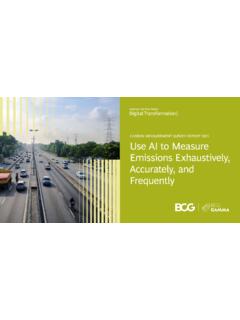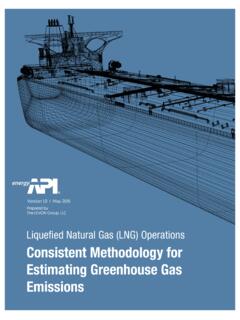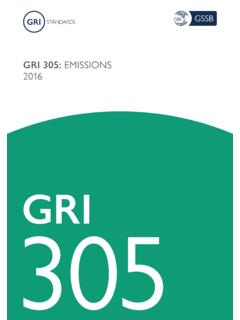Transcription of Analysis of Greenhouse Gas Emissions from Residential ...
1 1 Analysis of Greenhouse Gas Emissions from Residential Heating Technologies in the USA By: Nelson Dichter and Aref Aboud WCEC Technical Report September 15, 2020 Recommended Citation Dichter, N., & Aboud, A. (2020). Analysis of Greenhouse Gas Emissions from Residential Heating Technologies in the USA. UC Davis Western Cooling Efficiency Center. Acknowledgement The researcher acknowledges Trane Technologies for funding this research. Contacts Theresa Pistochini, UC Davis Western Cooling Efficiency Center, 2 EXECUTIVE SUMMARY Whole-building annual energy simulations were conducted using EnergyPlus to estimate the change in annual CO2 Emissions that would result from the replacement of natural gas furnaces with heat pumps in Residential buildings across the contiguous 48 states in the United States of America.
2 Four different heat pumps were simulated; a single-speed all electric heat pump, a variable-speed all electric heat pump, a single-speed dual-fuel heat pump, a variable-speed dual-fuel heat pump. Historical weather and marginal Emissions rates from 2019 were simulated for over 200 locations across the USA. Each location simulated represents a unique combination of DOE climate zone and electric utility territory. When compared to a natural gas furnace, the simulated heat pumps reduced CO2 Emissions in 15 states. The single-speed all electric heat pump reduced CO2 Emissions in 4 states, the variable-speed all electric heat pump reduced CO2 Emissions in 8 states, the single-speed dual-fuel heat pump reduced CO2 Emissions in 9 states, and the variable-speed dual-fuel heat pump reduced CO2 Emissions in 15 states.
3 The simulated heat pumps reduced CO2 Emissions by more than 10% in nine states and by more than 30% in 3 states. In the other 33 states, the simulated heat pumps increased CO2 Emissions when compared to a natural gas furnace by as much as 155%. The single-speed dual-fuel heat pump emitted less CO2 annually than the variable-speed electric heat pump in the 17 states where more than 15% of the electric power was generated through the combustion of coal except for 1 state where they were approximately equal. In the 31 states where less than 15% of the electric power was generated through the combustion of coal, the variable-speed electric heat pump emitted less CO2 annually than the single-speed dual-fuel heat pump in 9 states, the single-speed dual-fuel heat pump emitted less CO2 annually than the variable-speed electric heat pump in 20 states, and Emissions from the two heat pumps were approximately equal in 2 states.
4 If electric grids across the USA completely decarbonize in the future, between 65% and 90% of the CO2 Emissions reductions that would be achieved by all-electric heat pumps operating on a decarbonized grid would still be realized by dual-fuel heat pumps that are in service after that grid transformation. 3 INTRODUCTION Greenhouse gases (GHGs) are a group of compounds that have a high transmittance of most electromagnetic wavelengths of solar radiation but low transmittance of infrared (heat) radiation. The earth is continuously heated by solar radiation from the sun and cooled by emitting infrared radiation to the sky. When higher levels of GHGs are present in the atmosphere, more of the radiation being emitted by the earth is reflected back on its surface rather than escaping into space while solar radiation is still able to penetrate the atmosphere.
5 By trapping energy within earth s atmosphere, GHGs contribute to global climate change. GHGs include water vapor (H2O), carbon dioxide (CO2), methane (CH4), ozone (O3), nitrous oxide (N2O), and chlorofluorocarbons (CFC). Carbon dioxide is emitted as a byproduct of the combustion of fossil fuels (coal, natural gas, petroleum). The majority of GHG Emissions from human activities are in the form of CO2; 81% of the net global GHG Emissions in 2018 were CO2 [1]. Many regulatory agencies are pursuing electrification (converting natural gas appliances to electric appliances in new and existing construction) as a means of reducing carbon dioxide Emissions that result from natural gas combustion. Although electric appliances do not emit Greenhouse gasses directly, there are Emissions embedded in the electricity that powers them.
6 The embedded Emissions depend on the makeup and operation of the portfolio of power generation facilities of a particular electric grid. Most Residential buildings in California are heated and cooled by either a natural gas furnace paired with an air conditioner or an electric heat pump. Historically, natural gas furnaces have been less expensive to both purchase and operate; however, more aggressive standards limiting Emissions from natural gas appliances are increasing the cost of natural gas furnaces, shrinking the gap between the system cost of heat pumps and natural gas furnaces paired with an air conditioner. Electric heat pumps do not directly emit GHGs, but instead incur indirect Emissions which depend on the Emissions produced by the electricity generation and distribution infrastructure from which they are powered.
7 Electric grids are comprised of four main components: the generators which produce the electricity, the transmission lines that carry the high voltage electricity over long distances, the distribution network which transmits the electricity from the transmission lines to homes and buildings, and the load which draws power from the electric grid. The generators are the main component responsible for GHG Emissions ; however, the efficiency of the energy distribution infrastructure also plays a role in emission rates. On one end of the spectrum, if the electricity powering heat pumps is produced by renewable sources (solar, wind, hydroelectric, etc.) the indirect GHG Emissions rate is zero. The indirect GHG Emissions rate of electric heat pumps powered by modern natural gas burning power plants are similar to the direct Emissions rates of natural gas furnaces.
8 On the other end of the spectrum, if coal fired power plants are used to generate electricity to power heat pumps, the indirect GHG Emissions rate is two to three times higher than the direct Emissions rates of natural gas furnaces. Most electric grids have a diverse portfolio of power generation assets including some mixture of renewables, natural gas, and coal. The deployment of these assets varies depending on availability and demand. Dual-fuel heating systems, which contain an electric heat pump paired with a gas furnace, are an alternative technology that, depending on the makeup of the electric grid, could reduce annual GHG Emissions in some regions compared to furnaces paired with an air conditioner and all-electric heat pumps. In a dual-fuel system, the electric heat pump is used as the primary source of heat and the 4 furnace serves as the auxiliary source of heat.
9 The heat pump operates during mild temperatures. As the outdoor air temperature drops and the heat pump can no longer meet the heating load of the building, the system turns off the heat pump and switches to the natural gas furnace. By reducing the number of hours in the year that the furnace operates, the dual-fuel heating system reduces the annual GHG Emissions of the furnace. Conversely, by operating the furnace during the coldest hours of the year, the dual-fuel heating system avoids using electric resistance auxiliary heat or operating the heat pump when it is least efficient, both of which incur high GHG emission rates. The average carbon intensity (tons of CO2 Emissions per GWh of electricity generation) of electric grids varies across the USA from 133 tons/GWh in Washington to 298 tons/GWh in West Virginia with a United States average of 202 tons/GWh [2].
10 However, when considering the GHG Emissions from increasing the load on an electric grid (such as through widespread adoption of electrification) it is important to consider the marginal Emissions rate (MER). Utility grid operators respond to fluctuations in load on the electric grid by increasing or decreasing the amount of power that is purchased from various generation sources. These generation sources that operate on the margin are usually the most expensive and highest emitting power generators in the portfolio and contribute to the MER. As a result, the MER is almost always higher than the average carbon intensity of an electric grid. For example, although the state of Washington has one of the cleanest power generation portfolios in the USA, it has many coal powerplants that operate on its margin contributing to an average MER of approximately 2,026 tons/GWh.








